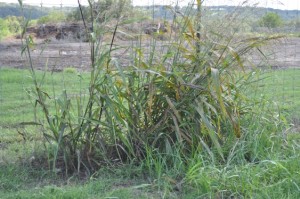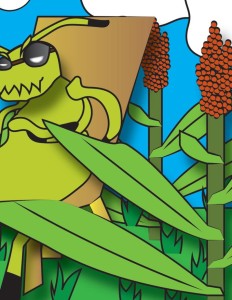Robert Bowling, Stephen Biles, Danielle Sekula-Ortiz, and Kate Harrell
Another season is upon us as farmers have begun seeding sorghum in the Lower Rio Grande Valley and Coastal Bend of Texas. Sorghum has emerged in the Valley and in some areas around Corpus Christi. Warm and dry conditions have made possible the early start to the season, especially when compared with the 2015 cropping year. How might these conditions influence sugarcane aphid infestations in sorghum?
Sugarcane aphid reproduction is favored by hot and dry conditions. Currently, sugarcane aphids have been observed overwintering on Johnsongrass as far north as Hill County. There were numerous cast skins in aphid colonies observed around Corpus Christi up to Austin County suggesting that sugarcane aphids are maturing and producing offspring. It is possible that they will start moving to sorghum early this season. What is the path forward to protect the crop from sugarcane aphid injury in 2016?
Know the aphid. Proper identification is important. The sugarcane aphid has a tan to green body and dark cornicles (tailpipe-like structure on the rear of the body) and dark feet (Images can be viewed HERE).  Take a magnifier glass with you when looking for the aphid as these structures are not visible to the naked eye. The aphid is typically found on the underside of sorghum leaves. It produces a lot of honeydew (shiny exudate) that is very noticeable on the top of leaves. If honeydew is observed, look at the underside of the leaf above the leaf with honeydew for the aphid. If the sugarcane aphid is found on Johnsongrass or volunteer sorghum start scouting sorghum shortly after plants have emerged.
Take a magnifier glass with you when looking for the aphid as these structures are not visible to the naked eye. The aphid is typically found on the underside of sorghum leaves. It produces a lot of honeydew (shiny exudate) that is very noticeable on the top of leaves. If honeydew is observed, look at the underside of the leaf above the leaf with honeydew for the aphid. If the sugarcane aphid is found on Johnsongrass or volunteer sorghum start scouting sorghum shortly after plants have emerged.
Start scouting sorghum early this season! If the planting seed was treated with an insecticide seed treatment the crop should be protected for 30 to 45 days. We recommended starting scouting about 30 days after the sorghum has emerged if the hybrid had an insecticide seed treatment. The first objective in scouting is detection. This involves weekly scouting of field edges (~25 feet into the field) and examining plants along 50 feet of row. Check all sides of the field for presence of the aphid. If no SCA are present, or only a few wingless/winged aphids are found on upper leaves, continue once-a-week scouting. This is a very quick process that provides an indication that the aphid has arrived in the field. Don’t forget to examine Johnsongrass and volunteer sorghum in ditches and bordering fields. For complete scouting recommendations please see the sugarcane aphid scouting card HERE.
Several hybrids have been identified as ‘tolerant’ to sugarcane aphid. You should be aware, however, that tolerance does not equate to immunity and all sorghum fields should be scouted for sugarcane aphid. Tolerant sorghum hybrids may require an insecticide application if sugarcane aphid populations reach treatment thresholds in south Texas. This is possible if the current environmental conditions persist this season.
Insecticide options for managing sugarcane aphid are very limited. Sivanto (Bayer) is currently the most effective product labeled for managing sugarcane aphid on sorghum and is safe to beneficial insects. Chlorpyrifos (Nufos, Lorsban, and others) is labeled for sorghum and when applied at 1 quart per acre, is effective against sugarcane aphid. Keep in mind that this rate has a 60 day pre-harvest interval (time from the application until the crop can legally be harvested) so this application needs to be made early. Also chlorpyrifos has a short residual and may be very hard on beneficial insects. Some research suggests that aphid populations may rebound quickly when this product is used. A Section 18 request for Transform has been made and is under review by the EPA. No decision has been made on this request to date. We will update you as we learn more about this.
Another important consideration when treating sorghum for sugarcane aphid infestations is the total volume of water applied to the field. Keep in mind that complete coverage of all foliage is critical for maximum performance of an insecticide targeting the aphid. Do not apply less than 10 gallons of final volume of spray solution per acre if treating with a ground rig and no less than 5 gallons per acre if the application is made by air. Incomplete coverage of an insecticide may fail to provide adequate suppression of sugarcane aphid and, as a result, the aphid may repopulate the field. An insecticide failure due to inadequate coverage may nullify any implied warranty on the products label. Remember, the second treatment (after a failure) is the most expensive application!
Predicting the occurrence and severity of insect pests is an imperfect science. A slight change in environmental conditions may have a profound effect on their populations. This is very true for the sugarcane aphid. If current conditions persist, the probability for sugarcane aphid outbreaks is likely. The big message here is DON’T BE COMPLACENT! Last year was characterized by wet and cool conditions in much of south Texas. This limited the aphid’s ability to reproduce and allowed insect predators to maintain sugarcane aphid populations to a low level. Remember how quickly the aphid increased its populations when hot and dry conditions returned to south Texas late in the 2015 season. Keep in mind that sugarcane aphid is easily managed when fields are routinely scouted and management options are implemented in a timely manner. Wising all of you the best
science. A slight change in environmental conditions may have a profound effect on their populations. This is very true for the sugarcane aphid. If current conditions persist, the probability for sugarcane aphid outbreaks is likely. The big message here is DON’T BE COMPLACENT! Last year was characterized by wet and cool conditions in much of south Texas. This limited the aphid’s ability to reproduce and allowed insect predators to maintain sugarcane aphid populations to a low level. Remember how quickly the aphid increased its populations when hot and dry conditions returned to south Texas late in the 2015 season. Keep in mind that sugarcane aphid is easily managed when fields are routinely scouted and management options are implemented in a timely manner. Wising all of you the best
this production season!